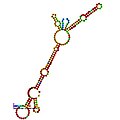GJA1
GJA1 or Gap Junction Alpha-1 Protein is a protein that in humans is encoded by the GJA1 gene. This protein is also commonly known as connexin 43 (Cx43) due to its molecular weight. GJA1 is crucial in the formation of gap junctions, which are specialized intercellular connections that facilitate the direct transfer of ions and small molecules between the cytoplasm of adjacent cells. This process is essential for various physiological functions, including cardiac conduction, vascular tone regulation, and the development of tissues and organs.
Function[edit]
GJA1 plays a pivotal role in the cardiovascular system, where it contributes to the propagation of electrical impulses across the heart, ensuring coordinated heart muscle contractions and maintaining normal heart rhythm. In the vascular system, GJA1-mediated gap junctions are involved in the regulation of vascular tone and blood pressure. Beyond the cardiovascular system, GJA1 is also important in the development and function of other tissues, including the brain, where it participates in neurodevelopment and the maintenance of the blood-brain barrier.
Genetic and Molecular Basis[edit]
The GJA1 gene is located on chromosome 6q22.31 in humans. Mutations in this gene have been associated with several medical conditions, including oculodentodigital dysplasia (ODDD), a rare genetic disorder that affects the development of the eyes, teeth, and fingers. Additionally, alterations in GJA1 expression and function have been implicated in various cardiovascular diseases, such as heart failure and arrhythmias, as well as in cancer progression and wound healing processes.
Clinical Significance[edit]
Understanding the role of GJA1 and its encoded protein, connexin 43, has significant clinical implications. For instance, targeting GJA1-mediated communication has been explored as a therapeutic strategy in cardiovascular diseases, to either enhance or inhibit gap junctional communication depending on the pathological context. In cancer, strategies to modulate GJA1 expression or function are being investigated to prevent tumor progression and metastasis.
Research Directions[edit]
Research on GJA1 continues to uncover its complex roles in health and disease. Studies are ongoing to better understand how GJA1-mediated intercellular communication influences disease progression and response to therapy in various conditions. Additionally, the development of drugs that can specifically target GJA1 functions holds promise for novel therapeutic approaches in diseases associated with GJA1 dysfunction.
See Also[edit]
References[edit]
<references/>
GJA1[edit]
-
GJA1
-
GJA1
-
Microphotograph of connexin 43 distribution in the rat myocardium
Ad. Transform your life with W8MD's Budget GLP-1 injections from $75


W8MD offers a medical weight loss program to lose weight in Philadelphia. Our physician-supervised medical weight loss provides:
- Weight loss injections in NYC (generic and brand names):
- Zepbound / Mounjaro, Wegovy / Ozempic, Saxenda
- Most insurances accepted or discounted self-pay rates. We will obtain insurance prior authorizations if needed.
- Generic GLP1 weight loss injections from $75 for the starting dose.
- Also offer prescription weight loss medications including Phentermine, Qsymia, Diethylpropion, Contrave etc.
NYC weight loss doctor appointmentsNYC weight loss doctor appointments
Start your NYC weight loss journey today at our NYC medical weight loss and Philadelphia medical weight loss clinics.
- Call 718-946-5500 to lose weight in NYC or for medical weight loss in Philadelphia 215-676-2334.
- Tags:NYC medical weight loss, Philadelphia lose weight Zepbound NYC, Budget GLP1 weight loss injections, Wegovy Philadelphia, Wegovy NYC, Philadelphia medical weight loss, Brookly weight loss and Wegovy NYC
|
WikiMD's Wellness Encyclopedia |
| Let Food Be Thy Medicine Medicine Thy Food - Hippocrates |
Medical Disclaimer: WikiMD is not a substitute for professional medical advice. The information on WikiMD is provided as an information resource only, may be incorrect, outdated or misleading, and is not to be used or relied on for any diagnostic or treatment purposes. Please consult your health care provider before making any healthcare decisions or for guidance about a specific medical condition. WikiMD expressly disclaims responsibility, and shall have no liability, for any damages, loss, injury, or liability whatsoever suffered as a result of your reliance on the information contained in this site. By visiting this site you agree to the foregoing terms and conditions, which may from time to time be changed or supplemented by WikiMD. If you do not agree to the foregoing terms and conditions, you should not enter or use this site. See full disclaimer.
Credits:Most images are courtesy of Wikimedia commons, and templates, categories Wikipedia, licensed under CC BY SA or similar.
Translate this page: - East Asian
中文,
日本,
한국어,
South Asian
हिन्दी,
தமிழ்,
తెలుగు,
Urdu,
ಕನ್ನಡ,
Southeast Asian
Indonesian,
Vietnamese,
Thai,
မြန်မာဘာသာ,
বাংলা
European
español,
Deutsch,
français,
Greek,
português do Brasil,
polski,
română,
русский,
Nederlands,
norsk,
svenska,
suomi,
Italian
Middle Eastern & African
عربى,
Turkish,
Persian,
Hebrew,
Afrikaans,
isiZulu,
Kiswahili,
Other
Bulgarian,
Hungarian,
Czech,
Swedish,
മലയാളം,
मराठी,
ਪੰਜਾਬੀ,
ગુજરાતી,
Portuguese,
Ukrainian



